First carabiners for climbing-summary.
Mechanical Advantage Series by John Middendorf

Buy the books here:
Volume 1: (mostly) European Tools and Techniques to the 1930s
Volume 2: (mostly) North American Climbing Tools and Techniques to the 1950s
Summary:
The common lore that climbing carabiners were ‘invented’ in 1910 is nuanced.
Carabiners were first used for rock climbing in the late 1800s.
Carabiners in 1910 were mostly used for body-weight only aid systems.
Stronger carabiners for running belays and able to withstand the forces of a runing belay fall appear more widely in the 1920s as a pear-shaped design, and became standard equipment for long multi-pitch technical rock routes by the 1930s, when strong oval carabiners then become the standard design.
The carabiner as we generally know and use them today first appear in the 1920s and 1930s as a standard climbing tool. Two or three carabiners were considered the most one would ever need, until the advent of the more technical big walls of the 1930s.
Early carabiner evolution (summary notes).
The myth of the “1910 first carabiner” was covered in a previous post. Recently I traveled to the American Alpine Club Library and was able to hold some of the oldest climbing carabiners in my hand. The researched early history of the carabiner with its main function as part of a running belay goes like this:
As they were known in the English world, Snap Links were called Karabinerhaken in German, where various new designs were engineered in the 19th century, and evolved with the availability of better steels, with many types of snap links for various purposes. Many designs were available in the early 1900’s.

The fireman’s rope access device, a forged steel design, had been adopted by a small number of climbers but not widely used, as they were specialized, costly, and heavy. The original use was as a device attached to a waist harness for rope work, much like we use a GriGri today, though the idea of a mechanical belay for a leader was still a distant concept. These “Pompier belts” with a strong forged openable link date back to the mid-19th century and were noted in the journals as a climbing and rescue tool as early as 1887 (see appendix).
In the Elbsandsteingebirge, climbers with a single free-carabiner on their rack date as far back as 1892, primarily used to attach oneself to an anchor while setting new routes or for threading a rope through an anchor (footnote). Notes in the previous post on carabiner evolution and in Appendix 1 below, provide further information on the carabiners used in the Elbsandsteingebirge (Joachim Schindler Collection, Dresden).
So perhaps is more proper to say that carabiners were ‘invented’ for climbing in the late 1800s, and used as a temporary point of attachment, or by some as a rappel device, though the simpler and more widely available strong forged ring was more likely employed as a descending ring, though most climbers simply used a body friction rappel method to descend.
Toward the end of the 19th century, more climbers began using mass-produced steel snap links bent from round stock and with an openable gate, most likely designed for other purposes, but their legacy of deriving from the specialized versions made for a fire brigade Pompier belt continued, as it reinforced the importance of needing a high-strength version for climbing; but is more likely that early carabiners were adopted from mining and other industries that were also producing high-strength snap links (see appendix for examples). Knowledge of carbon steel (steel types and heat treatment) was still a domain of engineers and blacksmiths, and some faulty tools were introduced into the early belay/rope systems, and contributed to documented accidents involving equipment failure.
First known carabiners for pendulums and aid techniques
One design, a general-purpose link that probably first appears in the mid-19th century, made with a steel bending operation, is still a standard “snap link” design in the modern world for all sorts of applications (a typical load rating is about 120kg.). This design was adopted for early climbs involving aid and pendulums in the 1910s, a style that fully matured as a double rope technique by the 1930s (see Europe, part C).

It has never been clear who first used carabiners for complex lead climbs, as a means to winch oneself up on a piton with the rope, or as a pulley point for a tension traverse, but their initial use was primarily as a point of aid. The big wall techniques using carabiners were pioneered in the Wilder Kaiser by a number of climbers prior to WWI, Georg Sixt seems to have been one of the innovators. Still, history records Otto Herzog as the “inventor” perhaps because his routes were bold and became famous as testpieces of the new style of climbing involving artificial aid, i.e. engineering pitons and rope systems to help with the ascent of the biggest rock walls ever attempted at the time.

First “real” climbing carabiners, 1920s
Early “full-strength” carabiners recommended for climbing and used as part of a running belay appear more widely starting in the 1920s; these are the stronger pear-shaped snap links, made with a bending process from medium-carbon steel (with a good balance of ductility and strength) with a spring-loaded gate, and were used as part of a running belay; that is, as a means to clip a running belayed rope into a piton or other anchor to shorten the length of a leader’s potential fall. In other words, what we consider a “real” climbing carabiner, used to clip into protection while on lead, and most importantly, able to withstand the forces generated in a lead fall.


These stronger pear-shaped carabiners were the standard for a decade or so until strong oval carabiners become the standard carabiner in the later 1930s (some of the earlier oval shapes were weak due to the loading on the gate, as noted in the literature). Pear-shaped carabiners in the 1920s were strong enough to be part of a running belay and were capable of holding the longer (survivable) falls of the era, though perhaps not with a large margin of safety. Only some are marked with manufacturer details, but certainly, sourcing the right brand and reputation would have been important for early climbers using them in high-load situations; there are a few nice examples in the American Alpine Club museum/library and in a few online collections.


Hemp rope slings were safely used for running belays
Even into the 1930s, connecting the lead rope to an anchor with a short loop of knotted rope instead of a carabiner was still a standard running belay attachment method. What is definitely a big No-No today with nylon ropes, due to the low melting temperature of nylon, is any rope-on-rope dynamic system; the friction of a rubbing rope will quickly cut nylon rope or sling. Hemp and manila slings can withstand higher frictional cutting before failing and were safely used as the primary means to attach a lead rope into a piece of protection for the decades before widespread carabiner use. A hemp or manila rope-on-rope system was strong enough to catch a short fall, and even some long falls (see Piaz chapters). On the other hand, carabiners were favored for climbs involving aid from the rope, as a means to winch oneself upward on a piton using one of the lead ropes, or for a tension traverse where the belayer provides slack as the lead climber maneuvers laterally with rope tension. In the 1920s, most pieces of protection were still tied in with a sling, as having three carabiners would have comprised a top-notch rack, and many climbers would have had none or only a few carabiners on the long climbs in this early era, until the advent of climbs involving the heavy use of artificial aid in the 1930s.
Note about threading ring pitons: In the age of ring pitons before carabiners, some say that the climbers had to untie, then re-tie to thread a ring piton. Certainly, the climbers in the Elbsandsteingebirge were using this technique on routes with a couple of ring bolts and long runouts, but in general, the idea of untying and re-tying the lead rope as a standard technique is another myth of the age. There are a few cases referenced in journals of a climber untying and retying the lead rope on long rock routes, but mainly in cases where climbers have come across a fixed piton on established routes. I think it only happened when climbers did not have a "Seilring" (rope sling), a very standard piece of equipment for climbers who used pitons for protection and belays on first ascents. In other words, why would you thread the eye of a piton (or a ring piton) when you had a knotted sling to attach to the piton to create a running belay? Not to mention rope drag with the small ring of the typical ring pitons of 1910-1914. There are many more references to rope slings (Seilringe) than threading the climbing rope into a ring-piton. In other words, in the Eastern Alps prior to the widespread availability of carabiners, the need to untie/retie the lead rope was generally only employed by unprepared climbers (ohne Seilringe—without slings) who were repeating a route with fixed pitons.
Oval Carabiners 1930s and beyond
By the 1930s, steel oval carabiners with parallel sides and symmetric radius curves became a standard climbing carabiner design, and climbing with carabiners became the normal practice. It is likely that August Schuster organized the first mass-produced steel carabiners made specifically for climbing in the late 1920s or early 1930s.
The first American carabiners were likely the steel oval carabiners made for the US Army. The next carabiner breakthroughs will appear after WWII with lighter aluminum ovals with a pinned gate, then the D-shaped carabiner designed to lessen the loading on the gate opening, as well as many other shapes and types. Pear-shaped carabiners disappear for several generations and only become standard again in the 1980s as a preferred locking harness carabiner.


Postscript: what was just to be a quick update with a few new bits of evidence became this long post. Apologies for the protracted explanations but thanks for reading this far! Of course there are still missing bits of history to fill in, but the goal has been to cover the broad strokes in the developments of climbing carabiners. Please feel free to comment if you have any questions or anything to add. My interest is in the development of the tools and techniques that make big rock walls possible, and the wider-spread availability of strong carabiners in the 1920s and 1930s was a key to this end, but of course, more could be discovered about the developments of the bold mostly free climbing techniques in places like the Elbstandsteingerbirge (Dresden) to dive deeper into details of early carabiner use—see appendix below.
More evidence/tidbits:
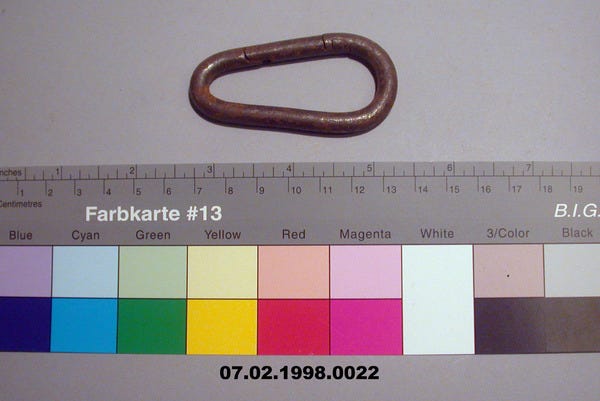




Appendix 1. Sammlung Joachim Schindler, Dresden
Evidence of carabiners in the Elbsandsteingebirge from Joachim Schindler (Dresden sandstone noted as the “low mountains”)
Joachim writes:
On some aspects - such as the date for the introduction of carabiners - there are very different versions of the information. For all technical equipment such as rings, hooks, carabiners, climbing ropes, rope slings, etc., there are various statements and claims. There is a date when these tools were generally known, but there were already individual users and experiments.
Perhaps another important statement: For a long time, Alpine historians paid little attention to what was happening in the low mountain ranges or viewed them with low value with regard to climbing technology. For example, the first climbing guide for Saxon Switzerland was published in 1908 - in other climbing areas many years later. With the climbing guide by Dr. Rudolf Fehrmann, ALL routes were classified in difficulty levels I to VII as early as 1923. Three years later, Welzenbach suggested a difficulty scale from I to VI!!!
- Around 1910 "Rambo" Herzog is said to have introduced the snap hook. My photos show climbers with rope slings and carabiners in Saxon Switzerland as early as 1892/93!!! I have more examples, but I'm still working on them myself.
Best regards from Dresden
Achim
Below images from the Joachim Schindler collection provided to verify carabiners in the Elbsandsteingebirge as early as 1892:






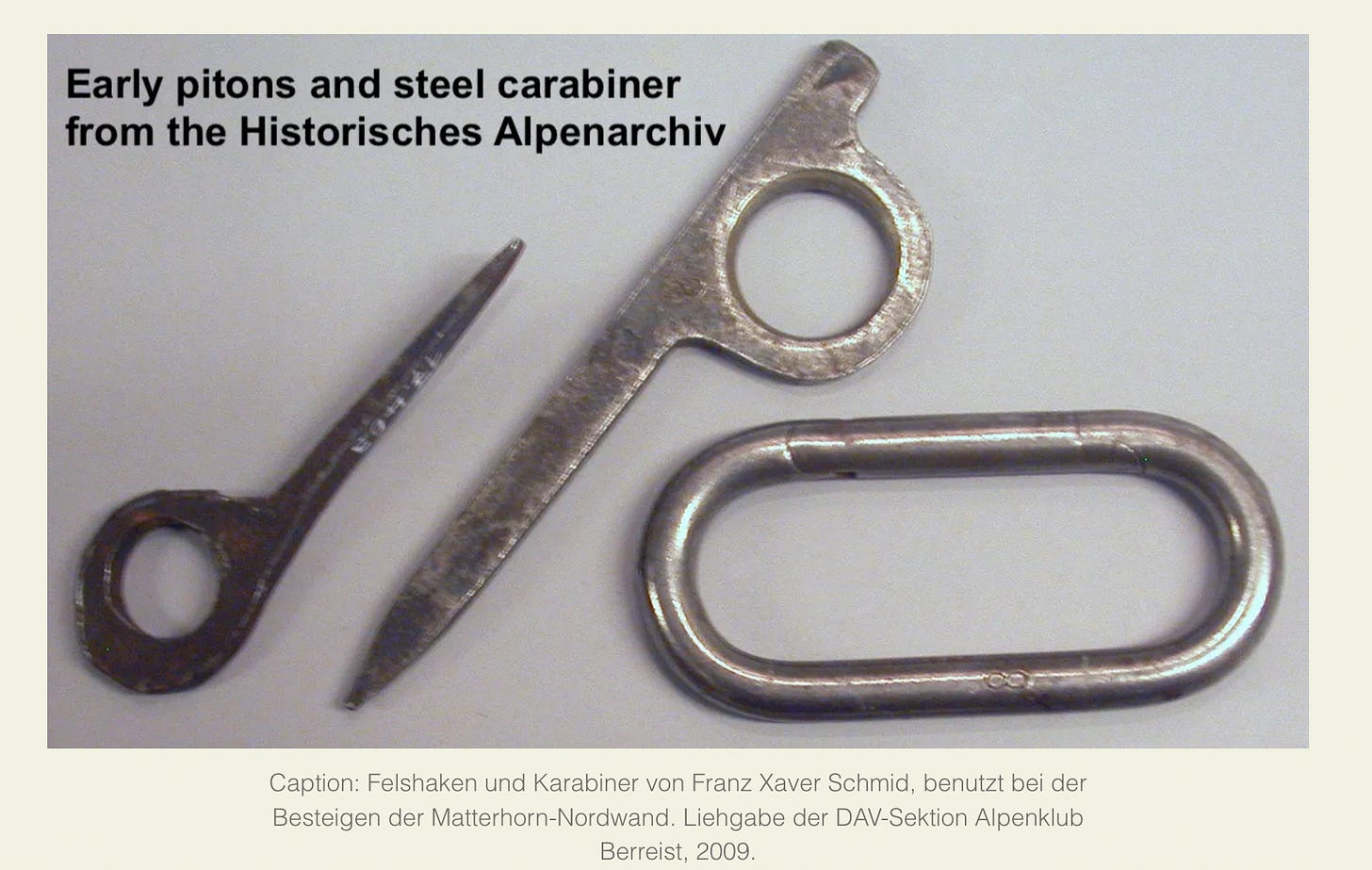
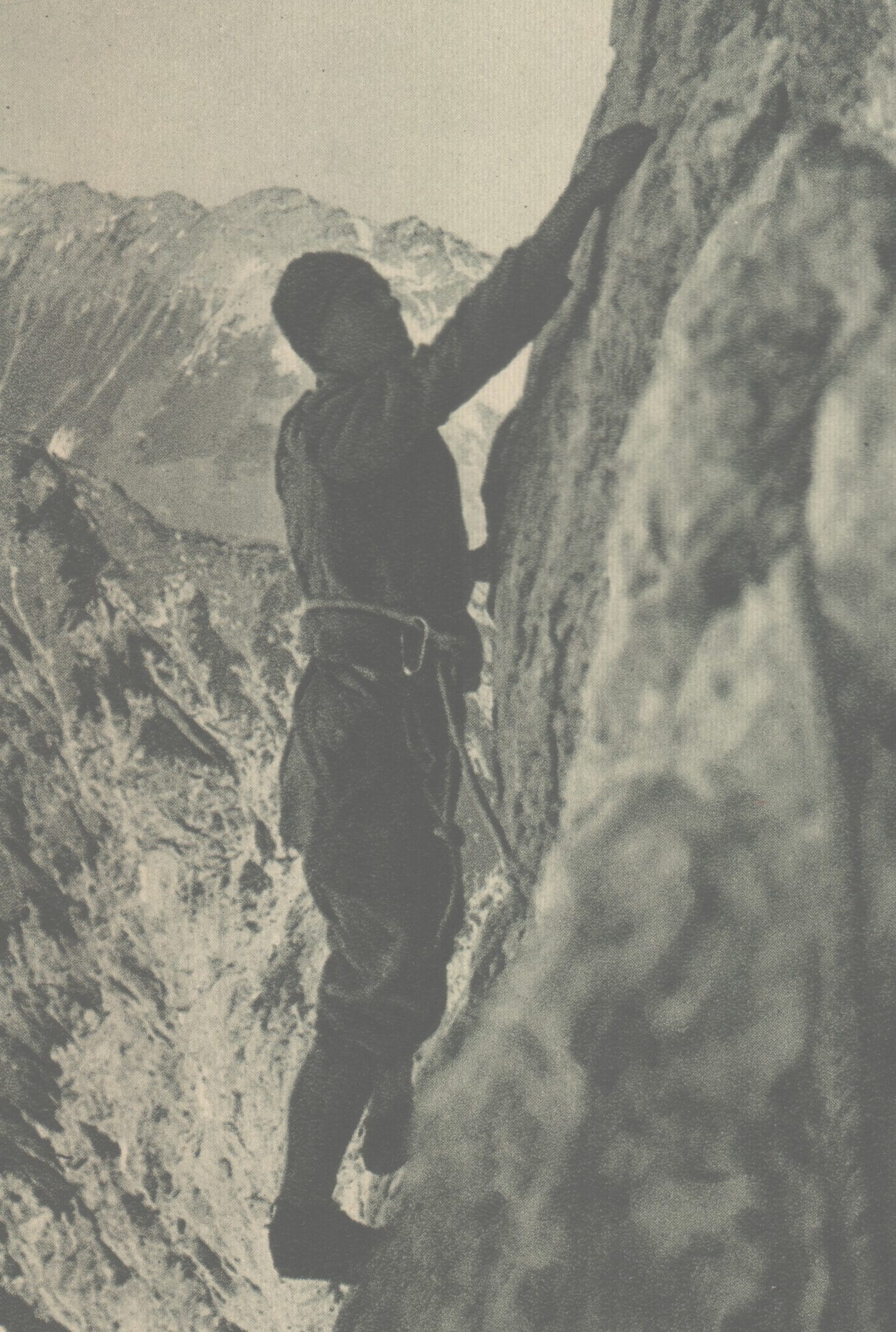
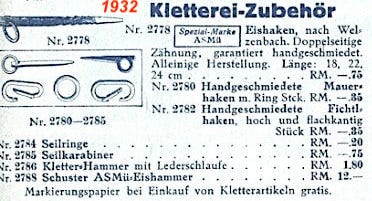
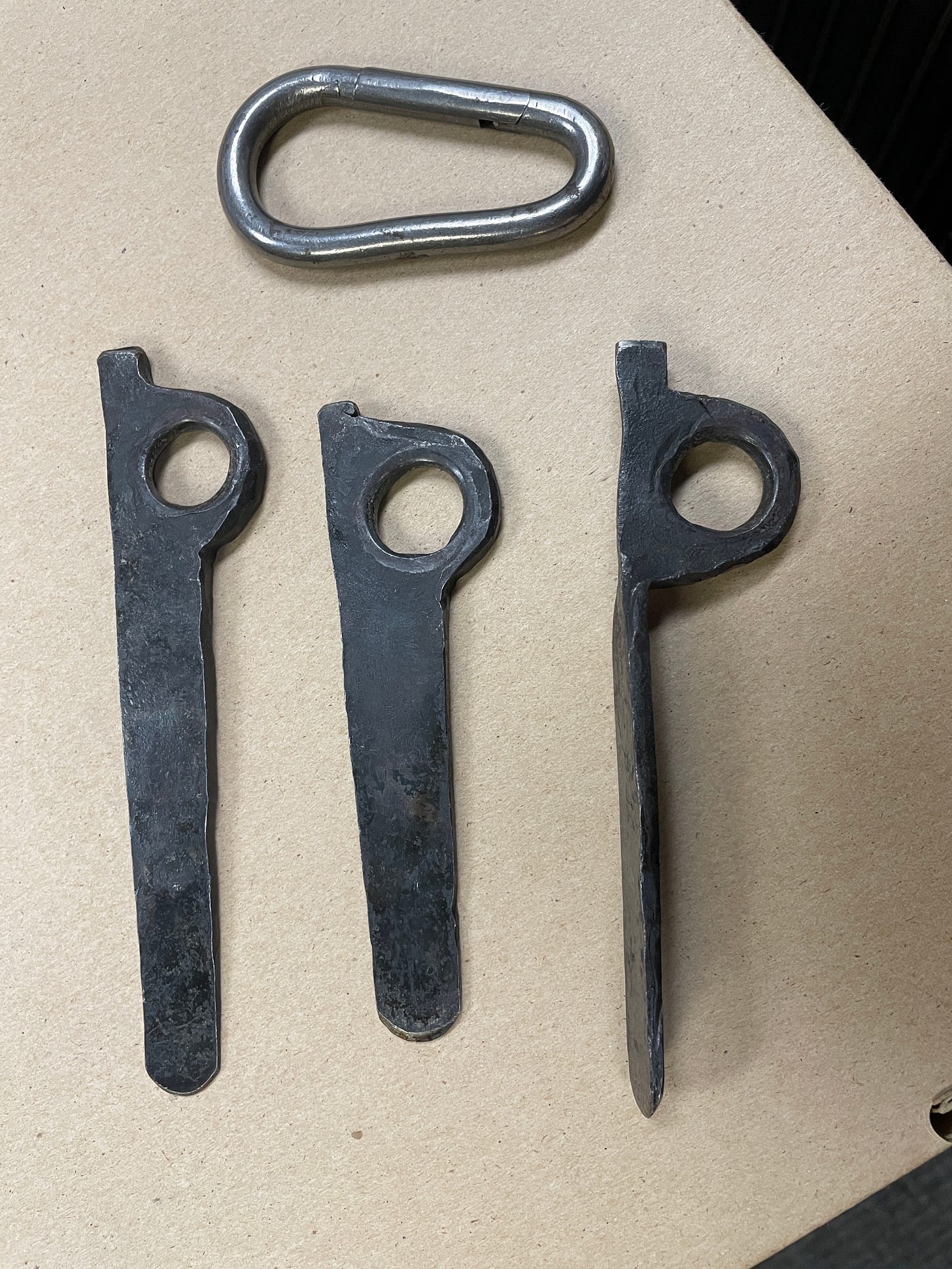




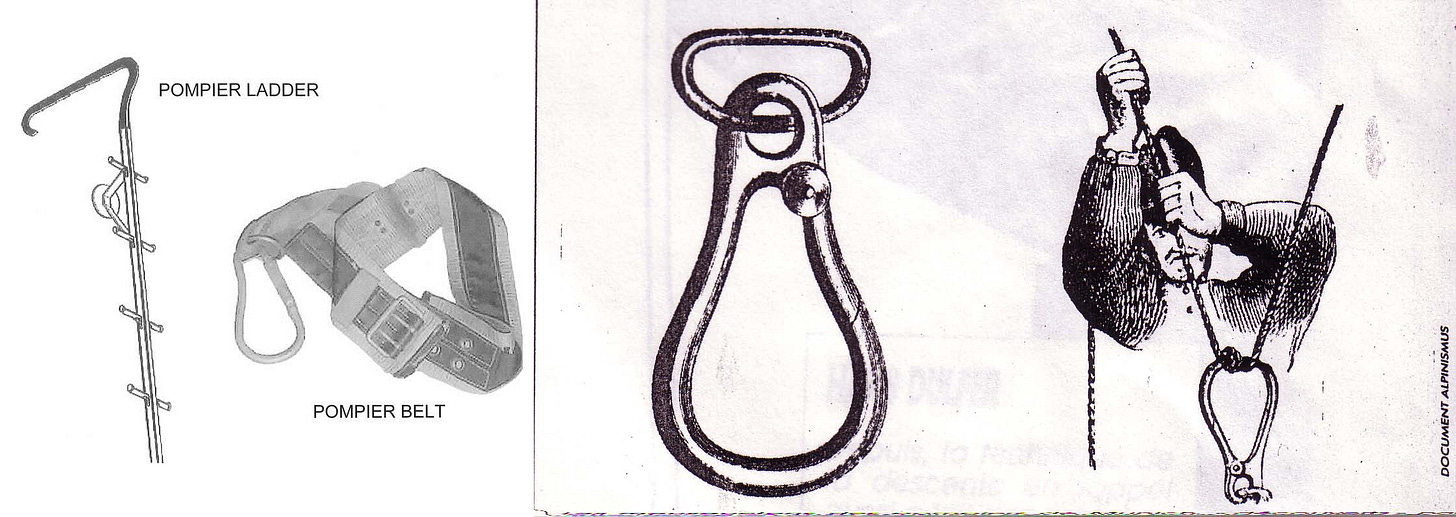




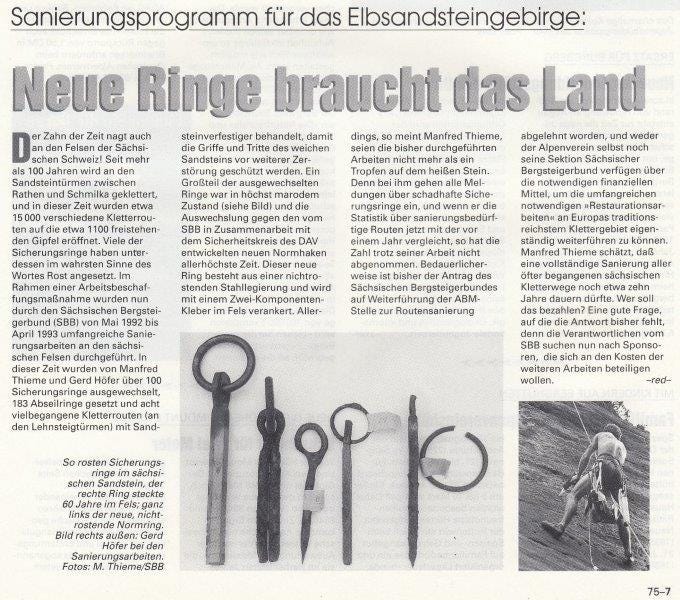

Wow, Deucey, you're uncovering a wealth of information! What the hell is a Pompier ladder?
My research on the history of carabiners has now been published here:
http://www.cavinguk.co.uk/info/verticalterminology.html#carabiner
Massive thanks for the research assistance!